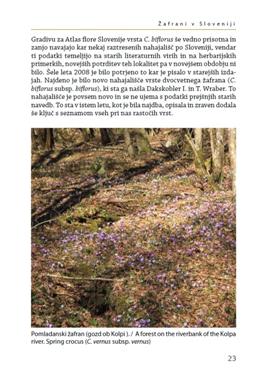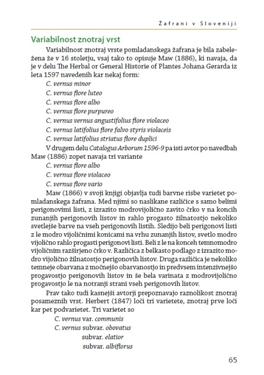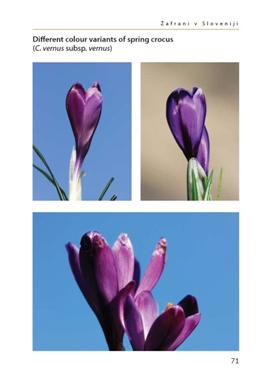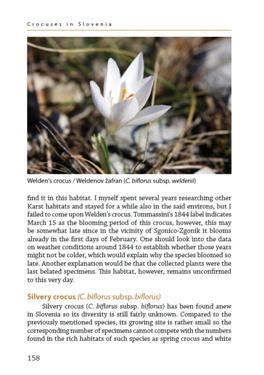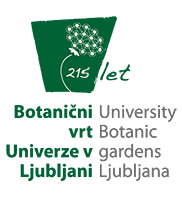Text in Slovenian and English
ISBN: 978-961-6822-04-6
Number of pages: 178
Size: 14,4 x 20,3 cm
PRICE: 19 €
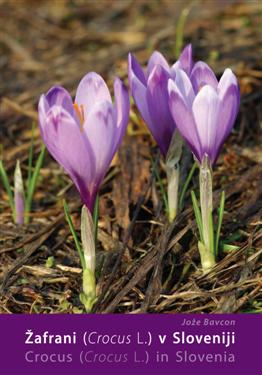
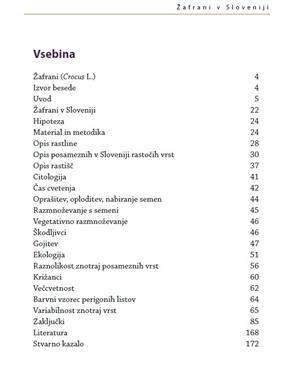
Etymology of the Word
Žafran, the Slovenian word for crocus, comes from the Arabic word zafaran, also zafran, which is Arabic for »yellow«. The word was adopted not only by the English (»saffron«) but was introduced also in most European, Asian and African languages, which points to the importance of the raw material as well as the ties existing between the areas of the then known world. Maw (1886) refers of a large number of European and non-European languages using the word safran or its derivatives. Similary, he cites the word crocus in connection with Hebrew, Syrian, Armenian, Arabian, Persian, Sanskrit, Greek, Latin etc, all of them using a similar root or a similar root derivative.
The Slovenian saying »As expensive as saffron« is associated with the fact that from 150 000 to 200 000 saffron flowers (Crocus sativus) had to be harvested to obtain 1 kg of the spice. It is native to Iran, Kashmir and Asia Minor. Notable for its lilac-tinted flowers, it is an autumn-blooming plant. Nothing but the red yellow-orange stigmas were removed from the flowers. This precious drug was used as a dye for food and clothing, a seasoning, and a spice, while also enjoying the reputation of a strong afrodisiac. It was known and cultivated already in antiquity. In a Thebes papyrus of 1553 B.C. it appears on the list of Syrian medicinal plants. Arabs continued to cultivate it also in later times so that after being forgotten for a while, it returned to Europe with the crusaders. The first to bring it to England were Phoenicians and later on Romans but the knowledge of these facts seems to have been lost. Given as the period of reintroducing both C. sativus and C. vernus is the middle of the fourteenth century (Campbell-Culver & Maggie 2001).
Introduction
The genus Crocus includes over 80 species. They grow in central and southern Europe, northern Africa, the Near East, central Asia, and western China (Brickel 1996). According to Herbert (1847), crocuses are plants of predominantly mountainous areas, but not thriving on alluvial soils. He also states that the genus makes part of the Mediterranean genera. Most of them are native to the Balkans. Thirty are reported in the work Prodromus Florae Peninsulae Balcanicae, by Hayek, Markgraf (1932,1933). Pulevič (1976) states 23 species and two hybrids for the territory of the former Yugoslavia, among these three endemics. Maw (1886) provides a very precise geographic determination of the crocus area for the northern hemispehere, namely, between 9° western longitude and 87° eastern longitude, and between 55° northern latitude and 31° southern latitude. The eastern border is at 50° longitude and the northern at 50° latitude. He divides the genus into four groups, corresponding to the said geographical division.
The first group covers the Pyrenean Peninsula and a part of France as far as the Rhone river where 10 species will be found. He adds a northern section of the African coast from Gibraltar to approximately the straight line along which the Rhone flows into the Mediterranean. Nine endemics are present here.
The second group covers the Apennine Peninsula to the northern line of the genus distribution; in the east a straight line runs up from Venice, and in the west the border runs along the Rhone discharge line. He reports 11 species, of these 8 endemics.
The third area includes the part extending from the afore-mentioned western border running up from Venice to, once again, the south-north line running through Odessa in the east. The southern part of this area covers the whole of the Balkans with the islands, the Peloponnesus and all Greek islands, extending as far as the coasts of Asia Minor and the Black Sea, all the way from Istanbul to the already mentioned Odessa line. 26 species grow here, 12 of them endemics.
The largest part of the area of this genus is Asia Minor with most of the Black Sea coast from the western Istanbul line to Odessa, extending to Caspian Lake in the east. This vast expanse is home to 32 species, 17 of which are endemic. A smaller part includes also the Near East, particularly the coastal strip with 7 species, 5 of them endemic. Taking a west-east view, the last part of the area is central Asia east of Caspian Lake, hosting a further two endemic species.
Due to the large number of species of this genus authors differ as to the actual number:
Herbert (1847) reports 43 species, Maw (1886) describes as many as 67, Bowles (1924, 1952) states 76, Mathew (1982) 80, and the same number is given also by Brickel (1996), while the IPNI Internet site refers to about 100 different species and subspecies (2009).
Herbert (1847) divides the genus Crocus simply into three groups: a group characterized in that the flower is involucrated, another group in which the flower has no involucre, and an intermediate group with a barely visible involucre. With respect to the tunic, these three groups are further divided into subsgroups.
